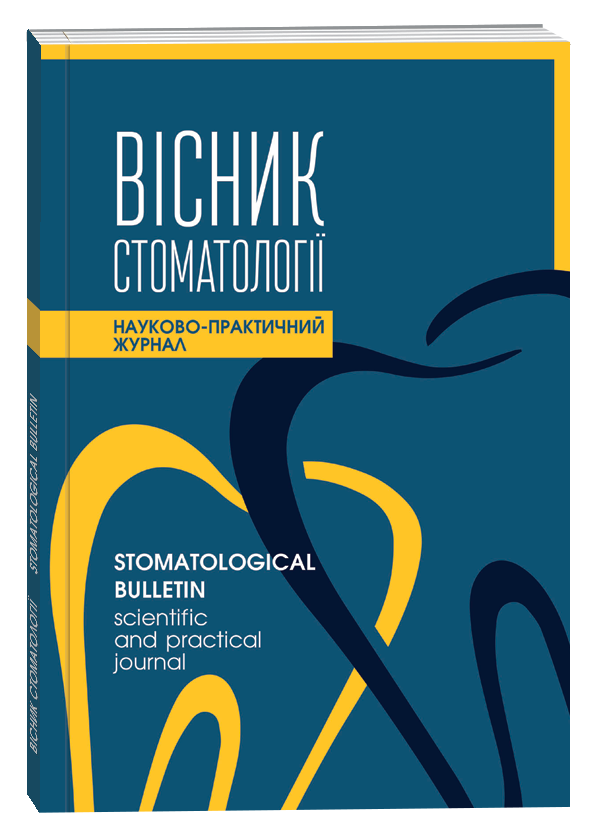SUBSTANTIATION OF THE SURGICAL TREATMENT OF PATIENTS WITH PLEOMORPHIC ADENOMAS OF SALIVARY GLANDS
DOI:
https://doi.org/10.35220/2078-8916-2020-38-4-48-53Keywords:
pleomorphic adenoma of salivary glands, mi-croRNA, extracapsular dissection, parotidectomyAbstract
Introduction. The pleomorphic adenoma (PA) is the most common benign tumor of salivary glands (60-90 %). The morphological, immunohistochemical, genetic study methods are applied for establishment of the final diagno-sis at the postoperative stage. The latter method is the most advanced and allows to detect changes in the mor-phologically intact tissue surrounding the tumor. The surgical treatment of the patients with PA of salivary glands involves the removal of tumor with the surround-ing salivary gland – from 2-3 mm to 2 cm respectively. Such an extensive range of reserve when removing the tis-sue of the intact gland with the tumor is attributed to the peculiarities of the PA capsule, multicenter growth, sig-nificant frequency of relapses. Thus, there is no scientific evidence of the answer to the following question: why it is necessary to remove not only the tumor, but the intact sal-ivary gland and to what extent.
The aim of the study – determination and substantiation of the resection margin of the intact gland in surgeries on PA of the parotid salivary glands.
Materials and methods. 27 patients with pleomorphic ad-enoma of the parotid salivary gland participated in the study. All patients were surgically treated with 3 methods – extracapsular dissection of the tumor, partial superfi-cial parotidectomy, superficial parotidectomy. The total RNA was isolated from the salivary gland tissue by means of phenol-chloroform extraction method, the concentra-tion and the purity of RNA was measured by means of ND1000 spectrophotometer. The expression of 34а and 29а microRNA was evaluated by means of real-time re-verse transcription and quantitative polymerase chain re-action.
The study results. The greatest expression of 34а and 29а of microRNA has been observed in the adjacent to the tu-mor capsule gland tissue at a distance of 5 mm – 1096,91±413,82 and 108,05±64,54 respectively, and the smallest one – in the intact gland which was not adjacent to the tumor and was located at 10 mm of the tumor – 47,5±32,01 and 8,33±4,8 respectively.
Conclusion. The most common surgery on pleomorphic adenomas of the parotid glands is the extracapsular dis-section of the tumor – 70,37 % of patients. The resection of 10 mm intact tissue of the salivary gland adjacent to the tumor is genetically substantiated when conducting the extracapsular dissection and partial superficial parotidectomy of the PA of the salivary glands.
References
Zbären P, Poorten VV, Witt RL, Woolgar JA, Shaha AR, Triantafyllou A, Takes RP, Rinaldo A, Ferlito A. Pleomorphic adenoma of the parotid: formal parotidectomy or limited surgery? Am J Surg. 2013 Jan;205(1):109-18. Doi: 10.1016/j.amjsurg.2012.05.026.
Jain S, Hasan S, Vyas N, Shah N, Dalal S. Pleo-morphic adenoma of the parotid gland: report of a case with re-view of the literature. Ethiop J Health Sci. 2015 Apr;25(2):189-194. Doi: 10.4314/ejhs.v25i2.13.
Lyu HX, Wang ZR, Gao YQ, Yu M, Li BQ, Zhang ZB. Clinical pathologic analysis on 3 724 cases of salivary gland tumors. Zhonghua Kou Qiang Yi Xue Za Zhi. 2019 Jan 9;54(1):10-16.
Brodetskyi IS, Malanchuk VO, Krotevych MS. Healthy Aging Research 2019; 8:9. (p. 1-6). DOI: 10.35248/har.2019.8.09.
Zbären P, Triantafyllou A, Devaney KO, Poorten VV, Hellquist H, Rinaldo A, Ferlito A. Preoperative diagnos-tic of parotid gland neoplasms: fine-needle aspiration cytology or core needle biopsy? Eur Arch Otorhinolaryngol. 2018 Nov;275(11):2609-2613. Doi: 10.1007/s00405-018-5131-0.
Brodetskyi IS, Malanchuk VO, Dosenko VE. Ex-pressions of microRNA-29a and microRNA-34a in pleomorphic adenomas of salivary glands. Gland Surg 2020. Doi: 10.21037/gs-20-284
Larian B. Parotidectomy for Benign Parotid Tumors. Otolaryngol Clin North Am. 2016 Apr;49(2):395-413.
Witt RL. The significance of the margin in parotid surgery for pleomorphic adenoma. Laryngoscope. 2002 Dec;112(12):2141-54.
Orabona GD, Bonavolontà P, Iaconetta G, Forte R, Califano L. the Parotid Gland: Extracapsular Dissection Versus Superficial Parotidectomy–Our Experience in 232 Cases. J Oral Maxillofac Surg. 2013; 71:410-413. https://doi.org/10.1016/j.joms.2012.05.003.
Beahrs OH, Adson MA. The surgical anatomy and the technic of parotidectomy. Am J Surg 1958; 95:885.
Brennan P.A., Ammar M., Matharu J. Contemporary management of benign parotid tumours – the increasing evidence for extracapsular dissection. Oral Dis. 2017 Jan;23(1):18-21.
Emodi O, El-Naaj IA, Gordin A, Akrish S, Peled M. Superficial parotidectomy versus retrograde partial superfi-cial parotidectomy in treating benign salivary gland tumor (ple-omorphic adenoma). J Oral Maxillofac Surg. 2010 Sep;68(9):2092-8.
Riffat F, Mahrous AK, Buchanan MA, Fish BM, Jani P. Safety of extracapsular dissection in benign superficial parotid lesions. J Maxillofac Oral Surg. 2012 Dec;11(4):407-10.
Hellquist H, Paiva-Correia A, Poorten VV, Quer M, Hernandez-Prera JC, Andreasen S, Zbären P, Skalova A, Rinaldo A, Ferlito A. Analysis of the Clinical Relevance of Histological Classification of Benign Epithelial Salivary Gland Tumours. Adv Ther 2019 Aug;36(8):1950-1974. Doi: 10.1007/s12325-019-01007-3.
Acunzo M, Romano G, Wernicke D, Croce CM. MicroRNA and cancer– a brief overview. Adv Biol Regul. 2015; 57:1-9. Doi: 10.1016/j.jbior.2014.09.013.
Denaro M, Navari E, Ugolini C, Seccia V, Donati V, Casani AP, et al. A microRNA signature for the differential diagnosis of salivary gland tumors. PloS ONE. 2019; 14(1): e0210968. Doi:10.1371/journal.pone.0210968.









